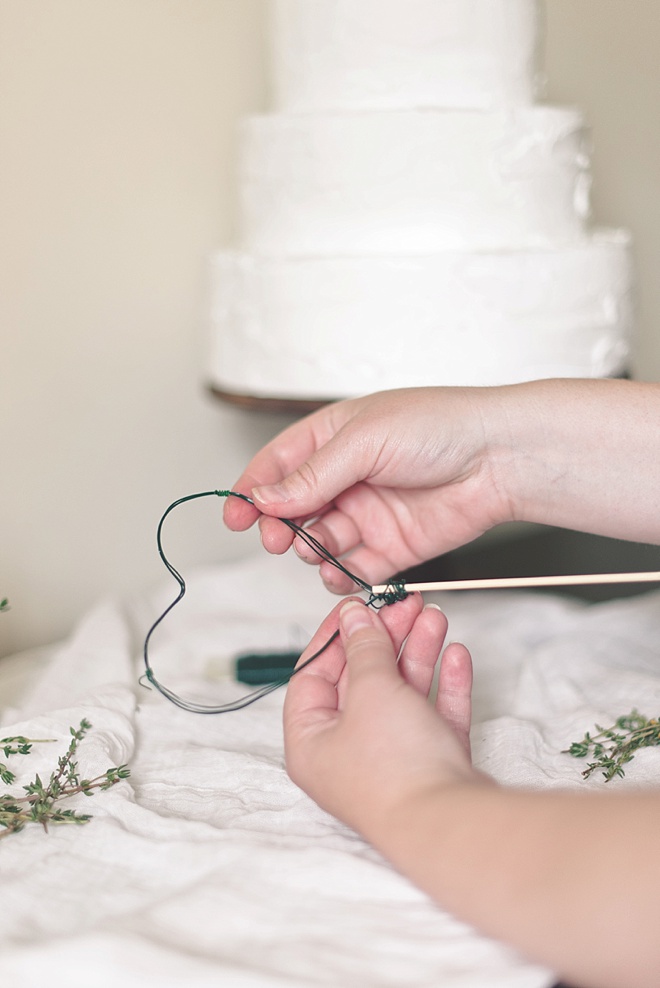Summer and the pandemic have brought about lots of home gardens and aspiring gardeners, so that means lots of herbs, veggies, and delicious kitchen treats to experiment with… including cake! Inspired by herbal textures, this rustic chic DIY cake topper tutorial celebrates the simply beautiful. For those looking for natural style on their special days, snip some thyme from your garden or buy some from the grocery store, and let’s get started!
PROJECT SUPPLIES:
- Bamboo skewer sticks
- Floral wire
- Fresh thyme
- FREE “Thyme Heart Outline” printable
- Clean garden shears (for cutting skewer to size)
- Wire cutters or scissors
- Adhesive tape (optional)
- Heart-shapped cookie cutter (optional if no printer)
STYLING SUPPLIES:
Maker’s Note
These cake toppers can be made into whatever shape you’d like! Circles, squares, diamonds, or anything that you can make out of wire! For this project, I have done a heart because, well, it’s celebrating love and it’s super cute, of course!
USE YOUR PRINTABLE TO MAKE HEARTS
Print off your “Thyme Heart Outline” printable. If you don’t have a printer, a giant heart cookie cutter might be your preference for helping shape your topper. You can also freehand a heart. Keep in mind most cake toppers are about 4.5” wide which is proportionate for most tiered wedding cakes.
CUT & SHAPE YOUR WIRES
To make a sturdy foundation for your cake topper, you’ll need to cut three pieces of 19” wires. Using your printable, mold your wires around the outline. If your wire is being wonky for you, use tape to adhere your wire to the outline. You should have “tails” to your heart; do not cut these just yet. You will need the tails to attach to your wood stick later on.
BIND YOUR HEART
Bind your three wires together using tiny bits of floral wire. Your binding wires should be minimal but enough to keep them together.
CUT SKEWER STICK & ATTACH
With your garden shears, cut a bamboo skewer stick to 4.5” long. Attach your heart to the stick by wrapping your wire heart’s “tails” around it.
PICK OUT YOUR THYME & CUT MORE WIRE
Choose sprigs of thyme that would suit your heart’s shape. Look for natural curves. You will need enough sprigs to completely cover your heart wreath-like shape. Cut small pieces of floral wire that you will use to attach your thyme to the heart.
ATTACH YOUR HERBS
Carefully attach your thyme to the heart with bits of wire. Wherever there seems like an empty spot on your cake topper, use tinier sprigs of thyme to fill the gaps. Your wires should be minimal, so be selective on where you place them.
PRESERVE YOUR CAKE TOPPER
If you want a fresh cake topper, make this topper a day in advance of your wedding, lightly wrap in plastic wrap/beeswax wrap, and keep in your crisper drawer in the fridge. If you want the equally lovely dried herb look, then make ahead as much in advance as you’d like and leave out of the fridge.
If you create one of our projects, please share a picture with us on Instagram or Twitter using the hashtag #somethingturquoisediy, we regularly reshare our favorites! Your profile will need to be public for us to see it otherwise, you can always DM us!
ABOUT THE MAKER
Considered an enthusiastic creator in the wedding industry since 2009, Chelsea LaVere Barton is a retired wedding photographer, editor-in-chief of Coastal Virginia’s online wedding publication, Tidewater and Tulle, and co-owner of UK-based wedding signage shop, High Oak & Co. Before her photographer days, Chelsea was a classroom art teacher and adheres to the mantra of “making life more beautiful” in all she does. When she’s not DIYing, she loves to go on local British adventures with her husband, write about said UK adventures on It’s a Hard Biscuit Life, and quietly relax at home with their cat Pickles Barrington. You can find her scrapbook of life on Instagram.
DIY TUTORIAL CREDITS
Photography + DIY Tutorial: Chelsea LaVere Barton // Wood Cake Stand: Prop Options via Etsy // Bamboo Skewers: Amazon // Floral Wire: Amazon
SHOP THE SUPPLIES
Find the supplies you’ll need for this project from our affiliate links below.


























Comments